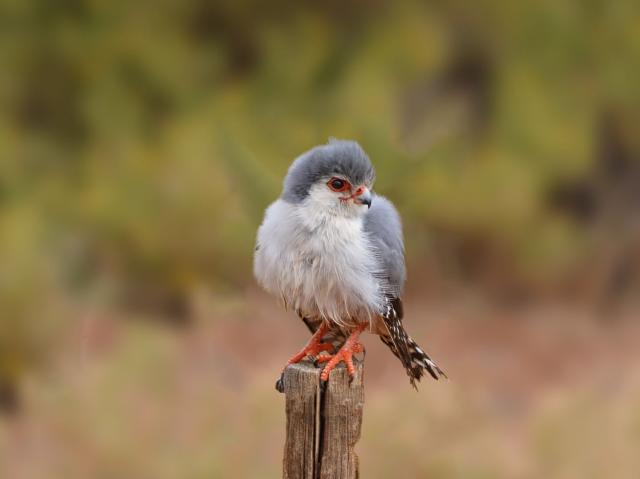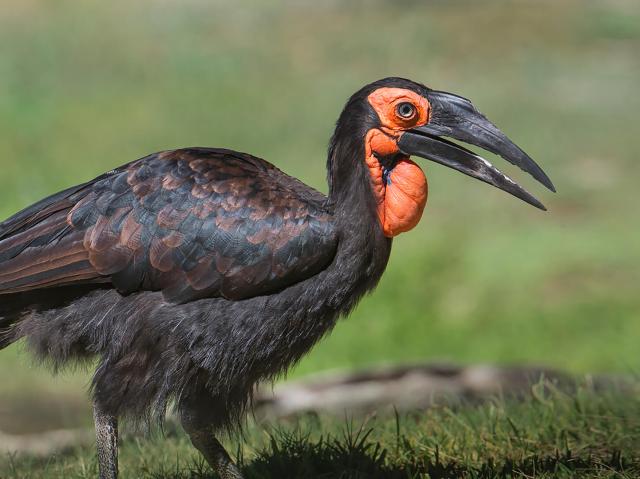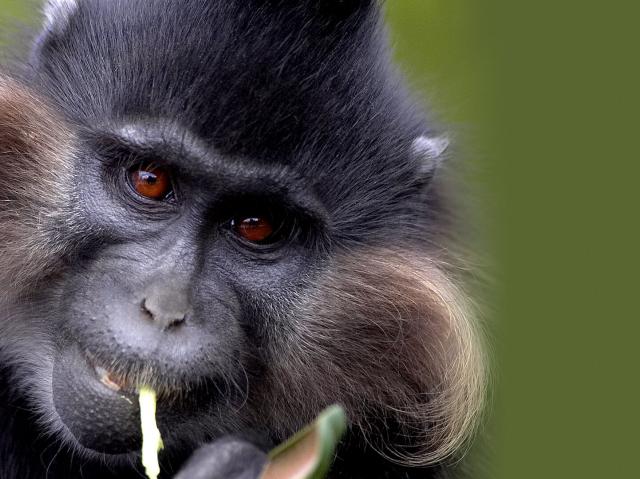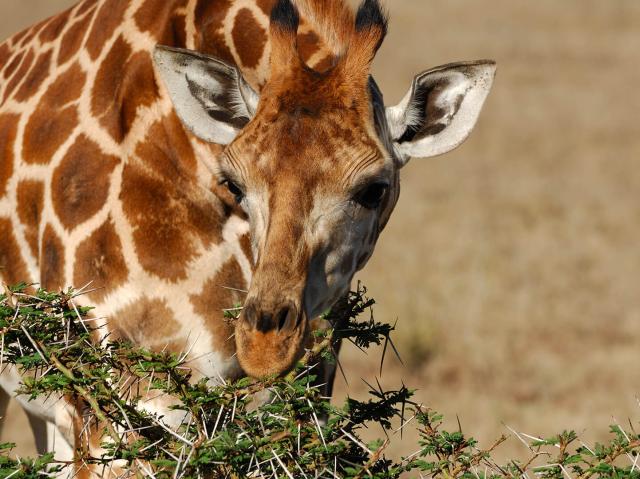
Lion

- CLASS: Mammalia (Mammals)
- ORDER: Carnivora
- FAMILY: Felidae
- GENUS: Panthera
- SPECIES: leo

ABOUT
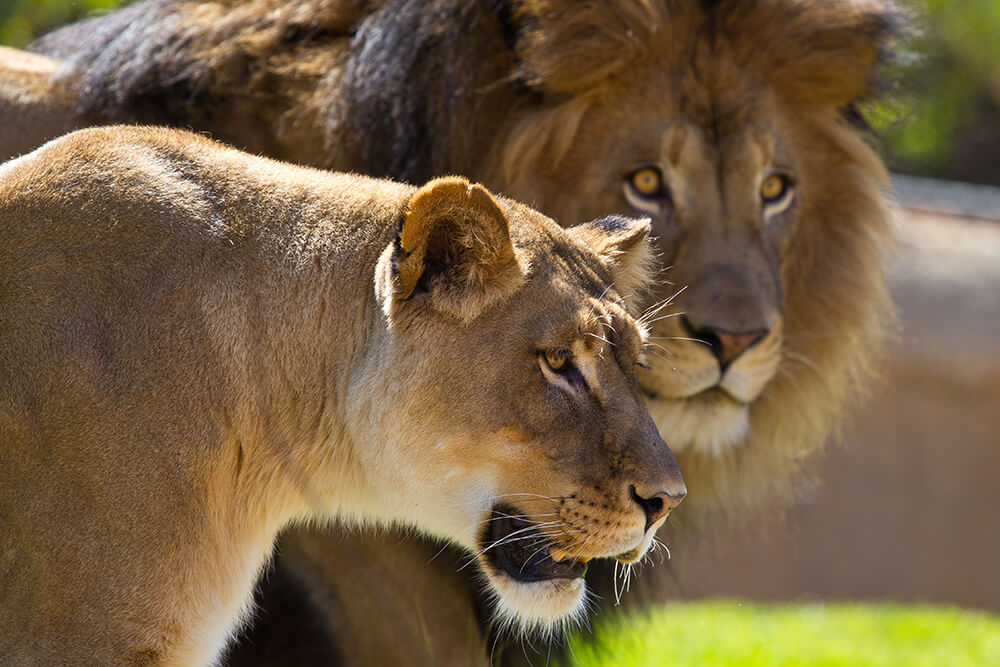
Lions have sparked our imaginations for centuries. Stars of movies and characters in books, lions are at the top of the food chain. The Swahili word for lion, simba, also means "king," "strong," and "aggressive." The word lion has similar meaning in our vocabulary. If you call someone lionhearted, you’re describing a courageous and brave person. If you lionize someone, you treat that person with great interest or importance.
Prime habitat for lions is open woodlands, thick grassland, and brush habitat, where there is enough cover for hunting and denning. These areas of grassland habitat also provide food for the herbivores that lions prey upon.
Lions differ from the other members of the large cat genus, Panthera—tigers, leopards, and jaguars. Adult male lions are much larger than females and usually have an impressive mane of hair around their neck. The color, size, and abundance of their mane all vary among individuals and with age. A mane’s function is to make a male look more impressive to females and more intimidating to rival males. A lion’s thick mane also protects his neck against raking claws during fights with other males over territory disputes or breeding rights.
Lions are also the only cats that live in large, social groups called “prides.” A pride can have 3 to 30 lions and is made up of lionesses (mothers, sisters, and cousins), and their cubs, along with a few unrelated adult males. The pride has a close bond and is not likely to accept a stranger. Unrelated males stay a few months or a few years, but older lionesses stay together for life. In dry areas with less food, prides are smaller, with two lionesses in charge. In habitats with more food and water, prides can have four to six adult lionesses. Both males and females scent mark to define their territory.
Living in a pride makes life easier. Hunting as a group means there is a better chance that lions have food when they need it, and it is less likely that they will get injured while hunting. Lion researchers have noticed that some activities are “contagious” within a pride. If one lion yawns, grooms themself, or roars, it sets off a wave of yawning, grooming, or roaring!
Lions and lionesses play different roles in the life of the pride. Lionesses work together to hunt and help rear cubs. This allows them to get the most from their hard work, keeping them healthier and safer. Smaller and lighter than males, lionesses have greater agility and speed. During hunting, smaller females chase prey toward the center of the hunting group. Then, larger and heavier lionesses ambush or capture the prey. Lionesses are versatile and can switch hunting jobs depending on which females are hunting that day and what kind of prey they're seeking.
While it may look like the lionesses do all the work in the pride, the males play an important role. While they do eat more than lionesses and bring in far less food (they hunt less than 10% of the time), males patrol, mark, and guard the pride’s territory. Males also guard cubs while lionesses hunt, and they make sure cubs get enough food. When a new male tries to join a pride, he must fight the males already there. The new male is either driven off or succeeds in pushing out the existing males.
Much of a lion’s life is spent sleeping and resting. Over the course of 24 hours, lions have short bursts of intense activity, followed by long bouts of lying around that total up to 21 hours! Lions are good climbers and often rest in trees, perhaps to catch a cool breeze or to get away from flies. Lions sometimes lie around in crazy poses, such as on their backs with their feet in the air, or legs spread wide apart!
Lions are famous for their sonorous roar. Males can roar at about one year old, and females can roar a few months later. Lions use their roar as one form of communication. It identifies individuals, strengthens the pride’s bond, and lets other lions know of the pride’s domain. Other sounds lions produce include growls, snarls, hisses, meows, grunts, and puffs, which sound like a stifled sneeze and are used in friendly situations.
Lions have other forms of communication as well, mostly used to mark territory. They spread their scent by rubbing their muzzle on tufts of grass or shrubs, and they rake the earth with their hind paws, as the paws have scent glands, too. Adult males also spray urine—stand back!
SaveSave
HABITAT AND DIET
Prime habitat for lions is open woodlands, thick grassland, and brush habitat where there is enough cover for hunting and denning. These areas of grassland habitat also provide food for the herbivores lions prey upon.
Lions usually hunt at night, particularly at dusk and dawn, with lionesses doing most of the work. A lion chasing down prey can run the length of a football field in six seconds. Their eyes have a horizontal streak of nerve cells, which improves their vision following prey across a plain. Lions have been spotted taking down prey as large as buffalo and giraffes! They may even drag this heavy prey into thickets of brush to keep other wildlife from getting to it.
Lions hunt antelope and other ungulates, baby elephants or rhinos, rodents, reptiles, insects, and even crocodiles. They also scavenge or steal prey from leopards, cheetahs, hyenas, or African hunting dogs (also called painted dogs), even eating food that has spoiled. Lions digest their food quickly, which allows them to return soon for a second helping after gorging themselves the first time.
At the San Diego Zoo and the San Diego Zoo Safari Park, lions eat a variety of meat as part of their comprehensive nutrition and wellness, including whole carcasses and large bones.
FAMILY LIFE
A lioness gives birth to her cubs in a secluded location away from the pride. At birth, each cub’s coat is yellowish brown and marked with distinct dark, rosette-shaped spots or, sometimes, stripes. Cubs remain hidden for four to six weeks as they gain strength, learn to walk, and play with one another and their mother. When they return to the pride, they can nurse from any adult lioness in the pride, not just their own mother. In fact, females in a pride often give birth around the same time, which makes for lots of playmates!
Cubs born in a pride are twice as likely to survive as those born to a lioness that is on her own. However, if a new adult male takes over the pride, he may kill cubs under one year old so that he can father his own. Under favorable conditions, a lioness can give birth to cubs roughly every other year.
From the time they are born, cubs have a lot to learn! At three months old, cubs can follow their mother wherever she goes, and they are weaned by the age of six months. At about one year old, males start to get fuzz around their neck that grows into the long mane adult male lions are famous for.
How long a lion cub stays with Mom depends on the sex of the cub. Mothers generally raise males until they are just about two. Once they hit that stage in life, their mother sends them off on their own. Sometimes sub-adult males form bachelor groups and run together until they are big enough to start challenging older males in an attempt to take over a pride. Mom cares for female cubs until about two years of age. They usually stay with the pride they were born into. A mother and daughter may live together for life.
Lions that do not live in prides are called nomads, and they range far and wide while following migrating herds of large game. Nomads are generally young males, roaming in pairs or small groups and often related to one another. Females are occasionally nomadic, too. For reasons not clearly understood, young females are sometimes driven from their pride like young males. As they gain age and experience, nomadic males may challenge established pride males for dominance of a given territory and its pride of lionesses, or they may join nomadic females and form a new pride.
AT THE ZOO
We began with a roar! Lions have been an important part of the San Diego Zoo’s history since the very beginning. There was no San Diego Zoo in 1915, when a male lion named Rex and two females, Rena and Cleopatra, arrived in town as part of the Panama-California International Exposition. It was soon after the Exposition ended that Harry Wegeforth, M.D., decided to create a zoo in San Diego after hearing Rex roar! Rex, Rena, and Cleopatra became some of the new Zoo’s earliest residents.
In 1923, an open-air lion grotto opened along what is now the Zoo’s Center Street. Cleopatra lived in the state-of-the-art habitat with another female named Queen and a male named Prince.
Lions have also lived at the San Diego Zoo Safari Park since it opened in 1972. Lion Camp mimics African habitat, offering opportunities for lions to express numerous natural behaviors like romping in the grass, exploring logs and rocks, or watching antelope, giraffes, and rhinos in the nearby African Plains savanna habitat. Guests can experience lions up close through a glass viewing window, making for some truly unforgettable moments.
A 27-foot-tall bronze sculpture of Rex, the lion whose roar inspired the creation of the San Diego Zoo in 1916, stands at the Zoo entrance. It honors the iconic status of lions in San Diego Zoo history and makes for a memorable photo opportunity for guests. To San Diegans, lions are symbolic of “their” zoo. Long may they reign!
CONSERVATION
Lion populations today face many growing threats such as habitat loss, a lack of available prey, and coexistence challenges. Conservation scientists estimate there are between 22,000 and 25,000 lions remaining in Africa and just under 700 lions living in India. The International Union for Conservation of Nature (IUCN) classifies lions as Vulnerable, but they note that some of the population is inferred to have declined at a rate that meets the criteria for Endangered.
Habitat loss poses the largest threat to lion populations. Natural habitat for lions is now found only in protected reserves, and lion movement between prides is becoming more limited. While lion hunting is banned in many African countries, trophy hunting is still allowed in some places. In some parts of Africa, conflicts between people and lions remain high. When prey becomes scarce, lions hunt livestock and people sometimes retaliate or seek to eliminate lions in the area. By taking appropriate steps to protect livestock, we can protect livestock, lions, and people.
San Diego Zoo Wildlife Alliance supports lion conservation in Kenya through our Savanna Conservation Hub, recognizing that lion conservation depends upon collaborative coexistence strategies. Some conflict may be unavoidable in areas where agriculture or livestock farming compete with lion habitats, but together, people are finding ways to coexist.
By joining San Diego Zoo Wildlife Alliance as an ally for wildlife, you help save species worldwide.
Sounds
LIFE SPAN
17 years on average
YOUNG
Gestation: Almost 4 months
Weight at birth: about 3 pounds (1.4 kilograms)
Age of maturity: 3 to 4 years
SIZE
Length: Females are 4.6 to 5.7 feet (1.4 to 1.7 meters); males are 5.6 to 8.3 feet (1.7 to 2.5 meters)
Weight: Females weigh 270 to 400 pounds (122 to 180 kilograms); males weigh 330 to 570 pounds (150 to 260 kilograms)
Tail length: 27 to 41 inches (70 to 105 centimeters)
FUN FACTS
A male lion can eat about a quarter of his body weight (as much as about 140 pounds or 63 kilograms) in a single meal.
A lion’s roar can be heard up to 3 miles (4.8 kilometers) away.
A lioness can sprint at up to 33 miles (53 kilometers) per hour.
A lioness often suffocates her prey by clamping her jaws overs its nose and mouth.
Scientists know more about lions than any other cat.
Some male lions do not have noticeable manes, seen most often in East Africa.
Lions can often survive in extreme drought conditions, eating tsamma melons (similar to watermelons) for moisture in the Kalahari Desert.







